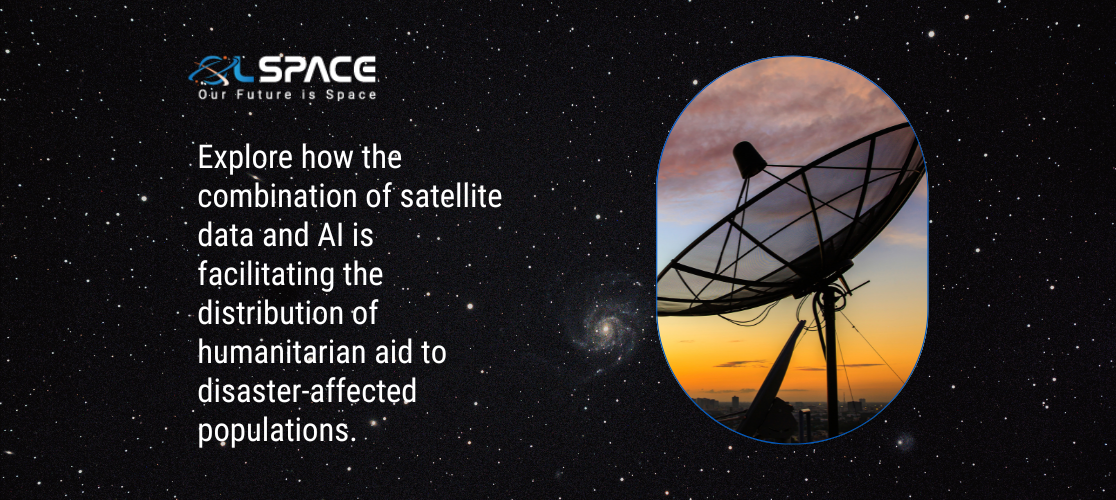29 September 2023
Explore how the combination of satellite data and AI is facilitating the distribution of humanitarian aid to disaster-affected populations.

The combination of satellite data and artificial intelligence (AI) is revolutionising the distribution of humanitarian aid to disaster-affected populations. This powerful synergy allows humanitarian organisations to respond more rapidly, efficiently, and effectively to natural disasters, conflicts, and other crises. Here’s how the integration of satellite data and AI is transforming humanitarian aid distribution:
1. Rapid Needs Assessment:
Satellite imagery provides a bird’s-eye view of disaster-affected areas, helping humanitarian organisations assess the extent of damage, identify affected populations, and pinpoint areas in need of assistance. AI algorithms can analyse this imagery to detect changes, assess infrastructure damage, and estimate population displacement quickly.
2. Targeted Resource Allocation:
AI algorithms, combined with geographic information systems (GIS), analyse satellite data and other sources to identify priority areas for aid delivery. This ensures that resources are allocated where they are needed most, optimising the impact of aid efforts.
3. Accessibility Mapping:
Satellite data can be used to create accessibility maps, which show road conditions, accessibility to affected areas, and potential transportation routes. AI can help identify the most efficient routes for aid delivery, factoring in road conditions, terrain, and logistical constraints.
4. Population Estimation:
AI algorithms can analyse satellite imagery to estimate the size of displaced populations in refugee camps or makeshift settlements. This information is crucial for planning and allocating resources for shelter, food, and medical care.
5. Damage Assessment and Prioritisation:
AI-driven image analysis can rapidly assess damage to infrastructure, including buildings, roads, and bridges. This information helps humanitarian organisations prioritise reconstruction efforts and allocate resources accordingly.
6. Early Warning Systems:
Satellite data, when combined with AI models, can predict and monitor natural disasters like floods, droughts, and wildfires. Early warning systems alert communities and humanitarian agencies in advance, allowing for timely evacuations and preparations.
7. Supply Chain Optimisation:
AI-driven analytics can optimise the supply chain for aid distribution. This includes forecasting demand, managing inventory, and dynamically adjusting logistics routes based on real-time data, reducing delays and inefficiencies.
8. Sentiment Analysis and Social Media Monitoring:
AI can analyse social media and online sources to gauge the sentiment and needs of affected populations. This data provides insights into the emotional well-being and specific requirements of disaster-affected communities.
9. Decision Support Systems:
AI-powered decision support systems process vast amounts of data from various sources, including satellite imagery, weather forecasts, and on-ground reports. They provide actionable insights to humanitarian agencies, aiding in informed decision-making.
10. Remote Monitoring and Evaluation:
Satellite data and AI enable remote monitoring of aid programs. Organisations can assess the impact of their interventions, gather feedback from beneficiaries, and make necessary adjustments in real-time.
11. Predictive Analytics for Disease Outbreaks:
AI can analyse satellite data, climate data, and historical disease patterns to predict and prevent disease outbreaks in post-disaster scenarios. This proactive approach helps safeguard public health.
12. Cost Efficiency and Transparency:
The use of AI and satellite data improves the cost-efficiency of humanitarian operations by reducing waste and optimising resource allocation. Additionally, it enhances transparency by providing real-time data on aid distribution.
In summary, the integration of satellite data and AI technologies empowers humanitarian organisations to deliver aid more effectively and efficiently to disaster-affected populations. This data-driven approach allows for quicker response times, more precise resource allocation, and improved coordination among stakeholders. As a result, the impact of humanitarian aid is amplified, and the suffering of affected populations is alleviated more effectively in times of crisis.
